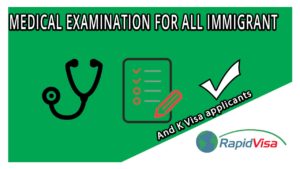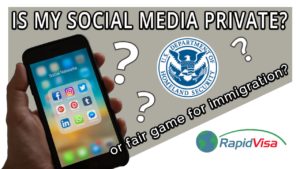Whether you are looking to sponsor a fiancé (K1) or spousal visa (CR1), keep in mind that U.S. Citizenship and Immigration Services (USCIS) has specific visa income requirements. These requirements are in place to ensure that the sponsored foreign national does not become a “public charge” – that is, to make sure that they are not financially abandoned and left to the welfare of the state and/or federal government.
Sponsor income requirements are based on the latest federal poverty guidelines published by the U.S. Department of Health and Human Services. For K-1 fiancé visas, the sponsor’s income must be at least 100% of that guideline; for CR1 visa income requirements, that requirement increases to 125%. Keep in mind that in addition to the type of visa you are applying for, the state you live in and the number of dependents in your household also contribute to the specific amount required.
RapidVisa offers a free Income Requirement Calculator to help you determine if you meet the monetary requirements. We’ve also compiled the most recent tables (current as of 2024) which you can find at the bottom of this article.
Stable, US-Based Income
USCIS mandates that declared income must be both US-based and stable.
U.S. Income: The reported income must be US-based, with some exceptions being made for military or government personnel based overseas. Evidence of proof of income is shown in the last three years of U.S. tax returns (gross income), pay stubs displaying “year to date” summaries, and a letter from the current employer noting position, date of employment, and annual salary rate.
Stable Income: “Stability” plays a major role in the USCIS decision process. Income derived from active employment, Veteran Administration benefits, retirement pensions, and Social Security are all stable forms of income, but income gained from unemployment is not. If the sponsor’s income is determined to not be “stable” by USCIS, there is a good chance that the visa request will be denied.
Utilizing Assets

Do you have a paid-off house? It may qualify as an asset.
For spousal visas or those seeking to adjust status (green card), cash or assets which are readily liquidated can be applied towards the income requirement. Typically, if the sponsor is a U.S. citizen, the assets must be worth at least three times the amount required from the poverty guidelines. However, if you are a green card holder, the assets must be five times the amount required by the poverty guidelines. That is, if you are required to earn $30,000 per year, you may be able to utilize $90,000 in assets to meet those criteria. Cash, certificates of deposit, stocks, mutual funds, life insurance policies and homeownership/equity are all examples of readily liquidated assets.
Specific Challenges
Self-Employed
Sponsors who work for themselves face additional income requirements. Since they are not on a “traditional” career path (and usually can’t get a letter from their employer), those who are self-employed must show bank account records going back at least six months and copies of their IRS 1099 forms. This is on top of the requirements for conventionally employed sponsors to provide U.S. tax returns. For those with their own businesses, a commercial rating concern report from Dun and Bradstreet can also be utilized.
Expatriates and Domicile
Another challenge at this stage of the visa process also faces American sponsors who have lived outside of the U.S. for an extended period of time. For those who are self-employed (common among this demographic), the U.S. tax returns and bank account forms noted previously are still required as is proof of residency (domicile) in the United States. The best practice, in this case, is to have the sponsor return to the US and establish a residence. Proving domicile can be tricky, as according to US law, the sponsor must possess a primary address in the United States and show that they intend to permanently maintain it.
Income Requirements for Fiance (K1) and Spousal (CR1) Visas
As noted previously, the annual gross income of K-1 fiancé visa sponsors must be equal to or greater than 100% of the federal poverty guidelines. For individuals seeking to secure CR1 spousal visas or adjust their status to lawful permanent residency (green card), that threshold increases to 125%. Also note that living in Hawaii or Alaska increases the threshold over and above those required for sponsors in the contiguous 48 states.
Contiguous US
(including Puerto Rico, Virgin Islands, Guam and Mariana Islands):
| Sponsor's Household Size | 100% of HHS Poverty Guidelines | 125% of HHS Poverty Guidelines |
|---|---|---|
| For sponsors on active duty in the U.S. armed forces who are petitioning for their spouse or child | For all other sponsors | |
| 2 | $20,440 | $25,550 |
| 3 | $25,820 | $32,275 |
| 4 | $31,200 | $39,000 |
| 5 | $36,580 | $45,725 |
| 6 | $41,960 | $52,450 |
| 7 | $47,340 | $59,175 |
| 8 | $52,720 | $65,900 |
| For each additional person | Add $5,380 | Add $6,725 |
*(Including all currently and previously sponsored aliens)
Alaska Residents
| Sponsor's Household Size | 100% of HHS Poverty Guidelines | 125% of HHS Poverty Guidelines |
|---|---|---|
| For sponsors on active duty in the U.S. armed forces who are petitioning for their spouse or child | For all other sponsors | |
| 2 | $25,540 | $31,925 |
| 3 | $32,270 | $40,338 |
| 4 | $39,000 | $48,750 |
| 5 | $45,730 | $57,163 |
| 6 | $52,460 | $65,575 |
| 7 | $59,190 | $73,988 |
| 8 | $65,920 | $82,400 |
| Each additional person | Add $6,730 | Add $8,413 |
*(Including all currently and previously sponsored aliens)
Hawaii Residents
| Sponsor's Household Size | 100% of HHS Poverty Guidelines | 125% of HHS Poverty Guidelines |
|---|---|---|
| For sponsors on active duty in the U.S. armed forces who are petitioning for their spouse or child | For all other sponsors | |
| 2 | $23,500 | $29,375 |
| 3 | $29,690 | $37,113 |
| 4 | $35,880 | $44,850 |
| 5 | $42,070 | $52,588 |
| 6 | $48,260 | $60,325 |
| 7 | $54,450 | $68,063 |
| 8 | $60,640 | $75,800 |
| Each additional person | Add $6,190 | Add $7,738 |
*(Including all currently and previously sponsored aliens)



